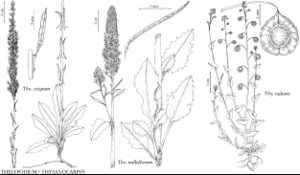Thysanocarpus radians
Pl. Hartw., 297. 1849.
Stems 1.5–6 dm. Basal leaves: blade oblanceolate, 1.5–4 cm, margins sinuate-dentate to runcinate-pinnatifid, surfaces usually glabrous, rarely sparsely hirsute, trichomes whitish, 0.3–0.4 mm. Cauline leaves: blade lance-ovate to lanceolate, widest at base, base auriculate-clasping, auricles extending around stem (at least some leaves). Racemes: internodes 9–18 mm in fruit. Fruiting pedicels weakly ascending, straight or nearly so, geniculately-reflexed apically, (proximal) 7–18 mm. Fruits flat, orbicular, (7–10 mm wide); valves pubescent or glabrous, trichomes pointed, ± 0.2 mm; wing entire or with undulate margins, rays distinct, ± 0.1 mm wide.
Phenology: Flowering Mar–Apr.
Habitat: Meadows in oak woodlands, fields, swales
Elevation: 20-400 m
Discussion
The large (7–10 mm wide), strongly rayed fruits and geniculately reflexed apices of fruiting pedicels make Thysanocarpus radians a very distinctive species. Occasional plants in northern California appear to be hybrids between T. curvipes and T. radians.
Selected References
None.

